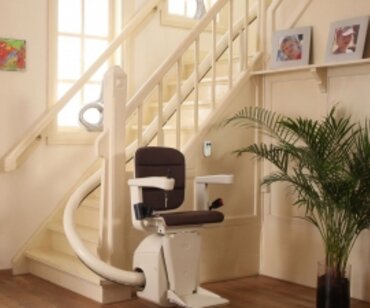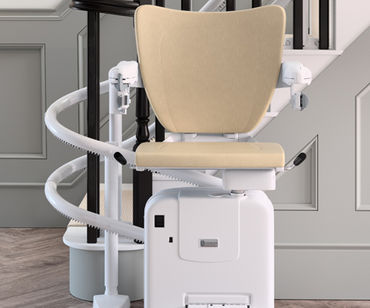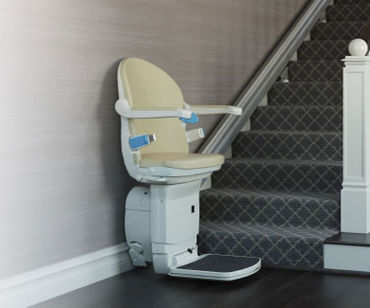A Guide to Accessible Public Transport

Anybody with limited mobility will rely on public transport in one way or another and with many separate companies having different procedures to ensure passengers with limited mobility get the best care, it can sometimes be confusing. Though prior planning removes any spontaneity from a day out, it also reduces the risk of disappointment to find that a certain coach company is not accessible or they could not fit on your wheelchair.
It can often be daunting to leave your home and stair lift behind, however as Britain bids to be more accessible, those in the public transport sector are making changes towards inclusivity. Whether you are looking to travel by bus, train, coach or ferry, we have collated all the details in one place.
Bus
Whether it is the iconic red bus of London or your local service, the bus is really important to local travel and interacting with your community. Whether you fancy a wander round the shops or coffee with a friend, you will be hard pushed to get there without a local bus service.
Stagecoach
Stagecoach provides transport to 90 major towns and cities, carrying around 2.5 million passengers every day and via 8,100 vehicles. With accessibility in mind, Stagecoach operates vehicles with lowered floors which have a limited space for number of mobility aids. These easy access busses are available on all routes and this is made clear on the schedules available.
Stagecoach also offers Journey Assistance Cards which anybody who needs assistance can apply for. These inform the driver if you have a problem with hearing or speech, but also if you need a little extra time to be seated or get up to the other end of the bus.
Arriva
Operating 5,900 busses in London, the north east, north west and south east of England, Yorkshire, the Midlands and Wales, Arriva has some weight in the UK public transport industry. They are also making enormous strides in terms of accessibility. Not only do they have busses with low floors, there are ramps available as well, though there are limited wheelchair spaces available on the vehicles.
Arriva’s vehicles also have a lot of extras in terms of inclusivity, with both visual and audio announcements of the coming stop to help those visually and hearing impaired. They also welcome Class 2 mobility scooters that do not exceed 100cm in length, 60cm in width and a turning circle of 120cm as these are most likely to fit in the space provided. The space available for wheelchairs is slightly more at 120cm in length and 70cm in width. The ramp on to the bus is able to take a weight of up to 300kg including the passenger and mobility aid. All information on their accessibility is available here.
First Group
First Group is the largest UK bus operator running over 20% of local bus services. It has a fleet of nearly 9,000 vehicles and carries on average 2.9 million passengers a day. They use the blue mobility logo to identify which of their vehicles have lowered floors and have been adapted for accessibility. They also make it clear that wheelchairs take a clear priority above buggies when it comes to the wheelchair space available on their busses.
First Group has also made a definitive guide to its stand on mobility scooters. While the company is happy to carry grade 2 mobility scooters, grade three mobility scooters are prohibited according to The Code.
Council Schemes
Similar to Journey Assistance cards, Devon County Council has developed a scheme to make it clear to all bus and train operators that the passenger may need extra assistance. The Devon Access Wallet is free to Devon residents and has been created to make local travel more inclusive and less daunting to residents.
The Devon Access Wallet scheme is similar to Warrington’s Bus Pass for Disabled People which assesses those who do not immediately qualify for a blue badge pass and would still benefit from low cost travel.
Trains

Whether you are just visiting the next town or making a trip across the country, train travel has been part of the British infrastructure since 1806. While train travel features in some of our most beloved literature from The Railway Children to Harry Potter, it has only recently made efforts towards accessibility.
Network Rail
Network Rail is the owner and manager of most of Britain’s railways. Though it may own most of the UK’s railway stations, in reality it manages very few of them, only 18, instead they are managed by private train operating companies (TOC). In terms of accessibility, Network Rail urges passengers with limited mobility to give a minimum of 24 hours’ notice to the train company and various stations in question. If unsure who you will need to contact, National Rail offer this page to help you.
Arriva Trains
Arriva trains operate mainly in Wales and services to and from Wales. Their pamphlet on accessibility not only states the help available at both manned and unmanned stations, but also informs passengers with limited mobility that they do not need to inform the railway more than 24 hours in advance, though can do if they so please.
There is also mention of delays or changes to service. Arriva Trains Wales will find alternative stations for disabled passengers if there is an inaccessible station as well as alternative transport if bus services are inaccessible. The number provided is for any customers to contact should they have queries over a station’s accessibility, and the information cannot be found on National Rail’s ‘Stations made easy’ page.
First Group Trains
Great Western Railways are under the First Group Train Service and are committed to inclusive and accessible service. Not only do they operate under the Devon Access Wallet Scheme but they also are making efforts towards accessible ticket windows, well-advertised blue badge spaces and well-trained staff. Welcoming mobility scooters on board, they have specified the dimensions they are able to carry at 120 cm long, 70 cm wide and 300kg including the passenger. There recent ‘Rail Accessibility Guide’ encloses not only all the different ways they aim to be inclusive, but also contact numbers in case you have further questions.
Govia
A joint enterprise between Go Ahead and Keolis, Govia is responsible for several different train services, including ThamesLink, Southern, Southeastern, London Midland, Great Northern, the Gatwick Express and Govia Thameslink Railway. Taking Southern as an example, Govia has gone to great lengths in order to make not only the trains and stations, but also the information about the facilities, accessible to all. With station maps and an easy accessibility guide that contains contact numbers should you have any questions, the company is allowing everybody to be informed when planning their perfect rail journey.
Southern asks you to book help if necessary 24 hours before you travel, ensuring you should not have to wait more than five minutes for assistance. They also recommend arriving at the station at least 20 minutes before your train is due and the platform five minutes before your train should arrive. Some stations have wheelchairs available, though you must use a ramp to board a train due to the gap between the train and the platform; this ramp cannot be used without supervision.
Serco
Serco is the authority behind the Docklands Light Railway, while it shares Mersey Rail and Northern Rail with Abellio. All DLR stations have step free access whether this is through level platforms or lifts. There is a helpful map that has the tube stations listed and their accessibility made clear.
While London has clear goals when it comes to the city’s accessibility, there is no exception with their transport. Most trains have at least two wheelchair spaces and the carriages these are placed in are denoted with a blue badge on the exterior of the carriage. Disabled Go is a website that allows anybody with interest to view different destinations and their accessibility. This is especially helpful as it covers many tube stations and a majority of the DLR stations allowing people to see at a glance whether staff at the station have equality training, if there is ramp or lift access, the contact details of the station and whether there are other mobility accessories such as seats and walkers available.
Stagecoach Rail
Stagecoach is involved with South West Trains, East Midlands Trains and Sheffield Supertram as well as their weight within the bus industry. East Midlands Trains has disclosed an Accessible Policies and Procedures pamphlet that marks not only the work towards continuously improved accessibility, but also their plans to station improvements in the next year. East Midlands Trains asks passengers looking to book the Passenger Assist System to do so 12 hours in advance to ensure the level of assistance required. However if you will be using another train operator’s services they recommend the usual twenty four hours.
There is also the ability to book wheelchair spaces on certain rail routes and if interested these can be booked up until midnight the day before a passenger travels. Wheelchairs of a certain dimension are as ever welcome on the train, however due to the many different trains that East Midlands Trains use, mobility scooter users must check first with the assisted travel team.
Virgin Rail Group
One of the big names in terms of transportation, Virgin Rail Group is known for its sleek and high speed services. Virgin Rail Care ask passengers to book assistance 24 hours before they travel, as well as reserve a wheelchair space on their trains if necessary.
Their document ‘Making Rail Accessible’ not only lists all 17 stations that they run, so you know who to contact with accessibility queries, but also the assistance rail staff will be able to provide. Though wheelchairs with a width of 70cm and a length of 120cm are welcomed, many larger mobility scooters are not as the dimensions cannot exceed those mentioned for manual wheelchairs. Wheelchairs are available at all Virgin Rail Group stations, and buggies are housed at some of the larger stations to help accessibility.
Coach

Coaches have long been a popular form of transport and while railways have lessened the popularity of the horse-drawn stage coach, the motorised modern alternative has long been popular for those who do not wish for the stress of a railway journey. While now they are synonymous with cheap and stress free transportation, are they as accessible as other forms of transport?
Megabus
Megabus is known for its cheap fairs and reliable service. Operating not only nationally, but also linking the UK to other European destinations, Megabus offers the perfect mode of transportation for those looking for an alternative to flying while still seeing Europe. If you use a wheelchair but can climb the stairs on to the coach, you can purchase your tickets by normal means and your chair will be stowed beneath the coach, however if this is not the case, you must call an alternative number (+44(0) 141 332 9841). It is also recommended that you reserve assistance 36 hours before you intend to travel.
Megabusplus is a form of intercity travel that is unfortunately not available to those with mobility issues, this is due to the service using both train and coach, and the coaches used are not accessible.
National Express
The name that is synonymous with British coach travel, National Express has long serviced the public’s needs of cross country commutes in comfort. While it is required that disabled or less mobile customers must inform National Express via email here if it is 36 hours before they travel. If it is less than that time, they must ensure they call an alternative number (03717 818181). National Express welcomes customers who wish to be transferred to a coach seat and those who would prefer to remain in their chairs, however for those looking for a seat, you can reserve a priority seat at the front of the coach to reduce the walking necessary. The company also cannot accept wheelchairs heavier than 20kg unless there is assistance at either end of the journey including connections.
Mobility scooters cannot be travelled in, however smaller and light weight scooters will be accepted as luggage. This must also be informed 36 hours in advance. The scooters suitable for travelling beneath the coach must break down into separate parts that weigh no more than 20kg and you must have a companion to assemble and disassemble the mobility aid at either end of the journey. Mobility scooters must also use dry cell or gel type batteries.
Scottish Citylink
Operating 19 routes within Scotland, Scottish Citylink also links Scotland to Northern Ireland. Only a few routes are currently available to wheelchair users. To check routes, availability and purchase tickets, passengers should call 0141 332 9644, If a space is not available at your chosen time, the company will look to find an alternative departure.
Scottish Citylink is ever increasing the accessible vehicles in its fleet and hopefully more routes will be available soon, though it is difficult to find on the website, the Assisted Travel page is clear and concise. As ever Scottish Citylink require 36 hours’ notice if you wish to travel with limited mobility.
Traws Cymru
Though Traws Cymru is a reasonably small operation, maintaining six routes across Wales, it keeps vital towns linked in a more direct manner than the alternative train routes. While there is limited information on the website, there is a telephone number (0300 200 22 33) so you can inquire about the accessibility of different routes and vehicles depending on your needs.
Trams

While trams may be something we associate with San Francisco and American streetcars, the first horse-drawn tram was actually established in Swansea before the New York streetcars came into play. Trams seem to have gone through every method of power, from the initial horse-drawn models, through gas, steam, cable to finally electric that we would recognise today. The first electric tram was in Russia in 1880 and today’s largest tram network is in Melbourne, Australia where it runs nearly 500 trams.
Metrolink
Consisting of seven lines throughout the city of Manchester, Metrolink oversees one of the larger tram networks in the UK. Metrolink has been designed with accessibility in mind and thus is much more adapted than many UK train lines as the vehicles and stations have been purpose-built. Every one of Metrolink’s 92 stops features step-free access from the street to the platform either by ramps or lifts where appropriate and tactile paving along the edge of every tram stop and at the specific boarding areas.
Within their Metrolink Access Guide, they explain the ease of usability of their lifts as well as the travel passes available to local residents and the numbers to call if you still are experiencing difficulties. Though initially mobility scooters were banned from the tramway, the smaller and lighter models are allowed passage however only if the appropriate permit is displayed.
Supertram
The Sheffield Supertram is part of Stagecoach and consists of three lines throughout the city of Sheffield. The Supertram has been working with Cranfield Institute of Technology to not only design the lay out of the tram stops, but also the variety of tactile paving to indicate the edge. The approach ramps and coloured paving display the difference between the safe and unsafe areas at the stop.
The Supertram accepts wheelchairs and electric wheelchairs however mobility scooters must have a permit. To enquire after a permit you will have to ring a dedicated helpline (0845 2666606).
Nottingham Express Tram
Though only consisting of two lines, the Nottingham Express Tram is vital to those who live near it. With a policy of ‘Access to All’, NET is honouring its promise. With all the vehicles having lowered floors, well-lit and well-designed platforms as well as contrast colouring to help the visually impaired, the Nottingham Express Tram is a lifeline to the city.
Not only are there dedicated wheelchair spaces but mobility scooters are also welcome as long as they can safely board the tram, manoeuvre into the designated space, and then exit the tram. The park and ride sites that feed the tram all have designated blue badge spaces as well as 24 hour CCTV and awards for safety. If you have any queries, their customer services will be happy to help (0115 942 7777).
Edinburgh Trams
Despite the city being traditionally built on seven hills that normally wouldn’t lend itself to accessibility, Edinburgh Trams is making efforts to change this. Lowered flooring on vehicles and dedicated wheelchair spaces as well as priority seating for those less mobile all account to the trams being a viable option. They also welcome electric wheelchairs, though scooters are dependent on a permit scheme, though temporary permits are available for those visiting the city.
The Mobility Scooter Leaflet ensures you are aware whether or not you are able to apply for a permit, while the form is simple and only a single page. The temporary permits are available at Travel shops, Park & Ride kiosks or Information Lounge at the airport tram stop.
Ferries

As a relatively small island in a big world, being surrounded by water has never held the British back. If air travel isn’t an option, the ferry is often a wonderful alternative, especially in the somewhat calmer summer months. Ferries have advanced immensely despite our nautical history, with many luxurious adaptations and activities to make a short crossing entertaining.
P&O
A historical company that originated in 1822 and is the oldest cruise line in the world, P&O is often thought of in conjunction with any channel crossing. While the Channel Tunnel is an alternative route, there is something special about leaving the iconic white cliffs of Dover in your wake as you set sail for France. If you don’t wish to take a wheelchair with you, or are concerned you will become weary on your crossing, P&O has a limited number of wheelchairs aboard each vessel.
If told in advance, the company is happy to ensure you are parked near a lift to the different facilities for customer convenience and staff are happy to assist less mobile customers on the vehicle deck. The shopping and dining areas are all accessible as well as the lifts. If you have any questions or need assistance, there is a number to call (08716 64 21 21). P&O journeys to many destinations beyond Calais and offers the perfect start to any holiday.
Wightlink
The Isle of Wight has long been a popular holiday destination, and whether you are there for music and culture, or weather and beaches, the ferry is the only way to get there. Wightlink is a popular ferry to transport eager tourists, with wheelchair loans and lifts on board, along with other disabled facilities and ramps. With a duration of 45 minutes, the ferry is not an extensive travel time, however despite this they make enormous efforts towards inclusivity.
There are blue badge spaces at Wightlink car parks, but they do ask to be informed of any mobility issues in advance.
Irish Ferries
Dublin to Holyhead is a popular journey and there is archaeological evidence that people have been sailing from Holyhead to Ireland for nearly 4,000 years. Irish Ferries makes this crossing regularly and has many adaptations to welcome its less mobile passengers. Though there is an expectation that passengers with reduced mobility will inform Irish Ferries two days before they travel, the vessels are fully wheelchair accessible, as are the ports. There are also wheelchairs available on board for those who do not wish to carry their own, dedicated seating areas and adapted facilities.
The accessible adaptations of each vessel are noted on the Accessibility Page so you can ensure you know where everything is. If not the friendly staff are there to help.
Things to Consider
With any journey, the mode of transport is not the only difficulty you will face, and this is especially true if you have reduced mobility. Ensuring stations at both ends of your journey and through any changes are accessible, is key, whether these are manned train stations or merely bus stops with a raised curb. Ensuring your ability to access the transport of your choice will make your travelling experience far better.
Arriving with plenty of time is often overlooked. Though many different types of transport attempt to be as punctual as possible, there are occasions when a vehicle is running late or comes a fraction earlier. Arriving early will ensure you have plenty of time to speak to a member of staff about what assistance you require as well as confirm you are in the correct area.
Image Credit: Oatsy40, David Ingham,



